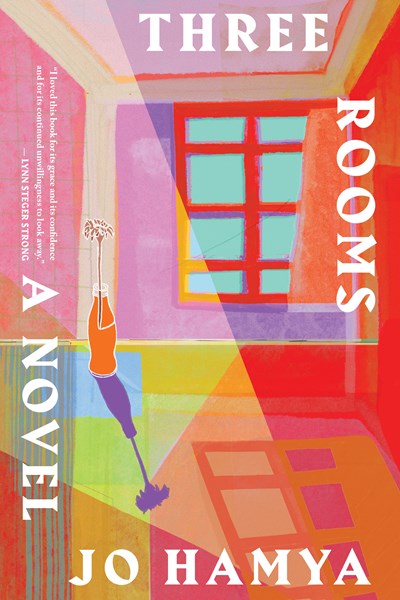[ad_1]
First published in 1929, the extended essay by Virginia Woolf, A Room of One’s Own, advanced the idea that women’s creative liberation could be garnered by securing two things: time and solitude. In material form, Woolf likened time and solitude to a room and independent, financial means. At the center of this landmark feminist essay was the notion that the accumulation of capital equaled liberation and that intellectual freedom was bound with the material. The nuance of this claim about materiality however should not be missed. Indeed, as Woolf concedes, writing itself is material—an embodied practice that is produced in protest of a material lack. Money then not only makes writing possible but also, in turn, makes available a rendering of our world that would otherwise be hidden from us. It is in this seemingly paradoxical space wherein money produces the freedom to write, which in turn makes visible our world, that Jo Hamya situates her troubling debut novel, Three Rooms.
Set in the fall of 2018, Three Rooms tracks the life and mind of an unnamed, millennial woman for a year as she moves through three rooms: one rented in Oxford, where she’s taken a position as a temporary research student; another, on the sofa of a stranger, the only “room” she can afford as a barely-paid copy editor at a society magazine; and the last, her childhood bedroom, which she returns to without a job or clear understanding of what lays ahead. In each of these rooms, Hamya’s protagonist plots. With more money, she could have a room of her own; with more money, she could establish a life that goes beyond the worry of making ends meet. In short, money, she imagines, could secure her a life far different than the one she’s currently living. And it’s this picture of difference that Hamaya’s novel obsesses over that complicates the Woolfian notion of a room of one’s own. No longer will a singular room suffice and no longer too will the image engendered by monetary freedom always produce a picture of real life.
In the time of the internet, everything is mediated, a fact that Hamya’s protagonist is acutely aware of. And still, her persistent draw to social media feels meaningful to a larger argument put forward by the novel: what is the relationship between intellectual freedom and materiality when materiality itself no longer directly mirrors the world around us but produces its own highly mediated forms of life? It is in these spaces that a certain analytical yet generous scrutiny churns. It’s here, too, that she tracks the online persona of a fellow research student, Ghislane, who, unlike Hamya’s protagonists, is monied, funded by her father’s momentary fame. Ghislane’s intellectual life, reflected in artfully constructed scenes, is sharply observed by Hamya’s protagonist as the latter character struggles to find a place within an alienating academic landscape. Her questions about Ghislane’s online presentation—can an online profile be a microcosm of life or how does one render their personality and taste in virtual form—are made all the more complex as she watches Ghislane take a photo in front of her flat, a space once lived in by Walter Pater. The astonishment and slight anguish are palpable as she reflects on the encounter with a neighbor: “Ghislane seems to have found a new way to impress herself on a space that doesn’t just rely on the physical. She filters herself into places via Instagram…she can do it with anything, even with photos of settings which clearly don’t belong to her.” It is not just that Ghislane renders her world visible via Instagram, it’s that the images constructed are all wrong. They are not earnest reflections of life. Instead, they are deceptive constructions; decadent imaginings vacant of any hint of the real. As Hamya’s protagonist notes, it’s not even Ghislane’s house.
And yet it’s no surprise that Walter Pater plays a role in complicating the Woolfian construction in Hamya’s novel. Well known for his phrase “art for art’s sake,” Pater proffered artistic autonomy, a type of withdrawal from the social in favor of the experiential. In the difference between Hamya’s protagonist and her loosely sketched counterparts, there lives more than just money and online personas. Race, too, differentiates Hamya’s protagonist. A woman of color, she sharply experiences the social and political divisions revealed by the Brexit referendum. As she moves from Oxford to London, her everyday experiences of office life are tinged by this fact. Her colleagues at a society magazine, deeply unattuned to the hardship incurred by the financial limitations of the position itself, offer impolitic advice on matters concerning her material reality and seemingly miss the point when Boris Johnson is elected, wondering if instead anyone might be an old school contact and capable of securing an interview. Opting for this bourgeois approach, they miss both the fear of impending austerity and the precarity that grows ever apparent.
Even as Hamya’s protagonist contends with her own uncertain future, she reflects, too, on the idea of a room: “What had a rented room in Oxford and a sofa in London made me? Where had there been to make me? For all my plans, it seemed impossible I could achieve anything…Yet somehow, I had spent the year keeping my possessions, temporarily, in what had been ostensibly the highest echelons the country had to offer.” Highly educated and culturally learned, Hamya’s protagonist belongs to a battalion of hyper-qualified yet precariously positioned twenty-somethings coming into a world very much in flux. And, while Woolf’s claim still echoes, Hamya alters the refrain. No longer will a room of one’s own hold all of the possibilities of intellectual freedom. Instead, there are more subtle and nefarious questions that complicate the links between intellectual freedom, materiality, and our highly mediated world. And they are certainly worth writing about.

FICTION
by Jo Hamya
Mariner Books
Published on August 31, 2021

[ad_2]
Source link
